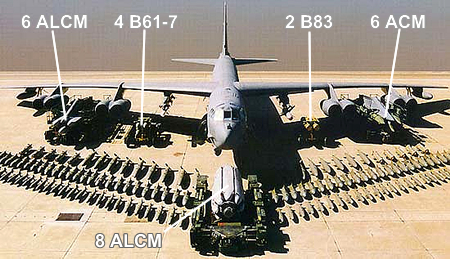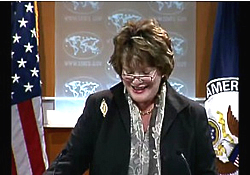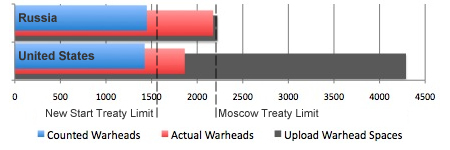 |
| An important new treaty reduces the limit for deployed strategic warheads but not the number. |
By Hans M. Kristensen
The White House has announced that it has reached agreement with Russia on the New START Treaty. Although some of the documents still have to be finished, a White House fact sheet describes that the treaty limits the number of warheads on deployed ballistic missiles and long-range bombers on both sides to 1,550 and the number of missiles and bombers capable of launching those warheads to no more than 700.
The long-awaited treaty is a vital symbol of progress in U.S.-Russian relations and an important additional step in the process of reducing and eventually perhaps even achieving the elimination nuclear weapons. It represents a significant arms control milestone that both countries should ratify as soon as possible so they can negotiate deeper cuts.
Yet while the treaty reduces the legal limit for deployed strategic warheads, it doesn’t actually reduce the number of warheads. Indeed, the treaty does not require destruction of a single nuclear warhead and actually permits the United States and Russia to deploy almost the same number of strategic warheads that were permitted by the 2002 Moscow Treaty.
The major provisions of the New START Treaty are:
- 1,550 deployed strategic warheads: Warheads on deployed ICBMs and deployed SLBMs count toward this limit and each deployed heavy bomber equipped for nuclear armaments counts as one warhead toward this limit.
- A limit of 700 deployed ICBMs, deployed SLBMs, and deployed heavy bombers equipped for nuclear armaments.
- A limit of 100 non-deployed ICBM launchers (silos), SLBM launchers (tubes), and heavy bombers equipped for nuclear armaments.
These limits don’t have to be met until 2017, and will remain in effect for three years until the treaty expires in 2020 (assuming ratification occurs this year). Once it is ratified, the 2002 Moscow Treaty (SORT) falls away.
Verification Extended
The most important part of the new treaty is that it extends a verification regime at least a decade into the future. The inspections and other verification procedures in this Treaty will be simpler and less costly to implement than the old START treaty, according to the White House.
This includes on-site inspections. Each side gets a total of 18 per year, ten of which are actual warhead counts of deployed missiles and the remaining eight being “Type 2” inspections of storage and dismantlement facilities.
Exchange of missile test telemetry data has been limited partly because it is not as necessary for verification as previously; there are other means for collecting this information. Even so, the treaty includes exchange of telemetry data for five test flights each year.
The Fine Print: Limits Versus Reductions
The White House fact sheet states that the new limit of 1,550 deployed strategic warheads is 74% lower than the 6,000 warhead limit of the 1991 START Treaty, and 30% lower than the 2,200 deployed strategic warhead limit of the 2002 Moscow Treaty.
That is correct, but the limit allowed by the treaty is not the actual number of warheads that can be deployed. The reason for this paradox is a new counting rule that attributes one weapon to each bomber rather than the actual number of weapons assigned to them. This “fake” counting rule frees up a large pool of warhead spaces under the treaty limit that enable each country to deploy many more warheads than would otherwise be the case. And because there are no sub-limits for how warheads can be distributed on each of the three legs in the Triad, the “saved warheads” from the “fake” bomber count can be used to deploy more warheads on fast ballistic missiles than otherwise.
| Under the New START Treaty That’s One Nuclear Bomb! |
 |
| The New START Treaty counts each nuclear bomber as one nuclear weapon even though U.S. and Russian bombers are equipped to carry up to 6-20 weapons each. This display at Barksdale Air Base shows a B-52 with six Air Launched Cruise Missiles, four B-61-7 bombs, two B83 bombs, six Advanced Cruise Missiles (now retired), and eight Air Launched Cruise Missiles. Russian bombers can carry up to 16 nuclear weapons. |
.
The Moscow Treaty attributed real weapons numbers to bombers. The United States defined that weapons were counted as “operationally deployed” if they were “loaded on heavy bombers or stored in weapons storage areas of heavy bomber bases.” As a result, large numbers of bombs and cruise missile have been removed from U.S. bomber bases to central storage sites over the past five years, leaving only those bomber weapons that should be counted against the 2,200-warhead Moscow Treaty limit.
Since the new treaty attributes only one warhead to each bomber, it no longer matters if the weapons are on the bomber bases or not; it’s the bomber that counts not the weapons. As a result, a base with 22 nuclear tasked B-52 bombers will only count as 22 weapons even though there may be hundreds of weapons on the base.
According to U.S. officials, the United States wanted the New START Treaty to count real warhead numbers for the bombers but Russia refused to prevent on-site inspections of weapons storage bunkers at bomber bases. As a result, the 36 bombers at the Engels base near Saratov will count as only 36 weapons even though there may be hundreds of weapons at the base.
If the New START Treaty counting rule is used on today’s postures, then the United States currently only deploys some 1,650 strategic warheads, not the actual 2,100 warheads; Russia would be counted as deploying about 1,740 warheads instead of its actual 2,600 warheads. In other words, the counting rule would “hide” approximately 450 and 860 warheads, respectively, or 1,310 warheads. That’s more warheads that Britain, China, France, India, Israel, and Pakistan possess combined!
| Dodging The Issue |
 |
|
Update March 30: Ellen Tauscher, the U.S. Under Secretary for Arms Control and International Security, was asked at a press briefing to explain the rationale behind the “fake” bomber warhead counting rule, but dodged the issue: “Well, I think what we want to do right now is talk about why this is an important treaty….” Increased transparency of bomber weapons would greatly improve the importance of the new treaty; the U.S. and Russia have more bomber warheads than the total nuclear weapon inventory of all other nuclear weapon states combined. If they have to use an arbitrary bomber warhead number because it’s too hard to verify, why chose 1? Why not 10 (as START I did) or 12, the medium loading capacity of U.S. and Russian bombers? |
The paradox is that with the “fake” bomber counting rule the United States and Russia could, if they chose to do so, deploy more strategic warheads under the New START Treaty by 2017 than would have been allowed by the Moscow Treaty by 2012.
Force Structure Changes
How the new treaty and the “fake” counting rule will affect U.S. and Russian nuclear force structures depends on decisions that will be made in the near future. In the negotiations both Russia and the United States resisted significant changes to their nuclear forces structures.
Russia resisted restrictions on warheads numbers to keep some degree of parity with the United States. It achieved this by the “fake” bomber weapon count and the delivery platform limit that is higher than what Russia deploys today. Under the New START Treaty, Russia can deploy more strategic warheads on its ballistic missiles than it would have been able to under the Moscow Treaty, although it probably won’t do so due to retirement of older systems. It can continue all its current and planned force structure modernizations.
The United States resisted restrictions on its upload capability, which it achieved by the high limit on delivery platforms. The “fake” bomber count enables more weapons to be deployed on ballistic missiles and more weapons to be retained at bomber bases than would have been possible under the Moscow Treaty. The SLBM-heavy (in terms of warheads) U.S. posture “eats up” a large portion of the 1,550 warhead limit, so the U.S. Nuclear Posture Review soon to be completed will probably reduce the warhead loading on each SLBM, and possible cut about 100 missiles from the ICBM force. The incentive to limit bomber weapons further is gone with the new treaty, although it could happen for other reasons. All current and planned modernizations can continue.
Although Russia has thousands of extra weapons in storage, all its deployed missiles are thought to be loaded to near capacity. As a result, under the New START Treaty, Russia will have little upload capacity. The United States, on the other hand, has only a portion of its available warheads deployed and lots of empty spaces on its missiles. The large pool of reserve warheads available for potential upload creates a significant disparity in the two postures so it is likely that the Nuclear Posture Review will reduce the size of the reserve.
| Estimated U.S. and Russian Strategic Warheads, 2017 |
 |
| Although the New START Treaty reduces the limit for deployed strategic warheads, a “fake” bomber weapon counting rule enables both countries to continue to deploy as many weapons as under the Moscow Treaty. A high limit for delivery vehicles protects a significant U.S. upload capacity, whereas Russia will have essentially none. Future force structure decisions might affect the exact numbers but this graph illustrates the paradox. |
.
Conclusions and Recommendations
The New START Treaty is an important achievement in restarting relations with Russia after the abysmal decline during the Bush administration. And extending and updating the important verification regime creates a foundation for transparency and confidence building.
The treaty will also, if ratified quickly and followed up by additional reductions, assist in strengthening the international nonproliferation regime and efforts to prevent other countries from developing nuclear weapons.
The United States and Russia must be careful not to “oversell” the treaty as creating significant reductions in nuclear arsenals and strategic delivery systems. Although the treaty reduces the limit, the achievement is undercut by a new counting rule that enables both countries to deploy as many strategic warheads as under the Moscow Treaty.
Indeed, the New START Treaty is not so much a nuclear reductions treaty as it is a verification and confidence building treaty. It is a ballistic missile focused treaty that essentially removes strategic bombers from arms control.
The good news is that a modest treaty will hopefully be easier to ratify.
Because the treaty protects current force structures rather than reducing them, it will inevitably draw increased attention to the large inventories of non-deployed weapons that both countries retain and can continue to retain under the new treaty. Whereas the United States force structure is large enough to permit uploading of significant numbers of reserve warheads, the Russian force is too small to provide a substantial upload capacity. Even with a significant production of new missiles, it is likely that Russia’s entire Triad will drop to around 400 delivery vehicles by 2017 – fewer than the United States has today in its ICBM leg alone. That growing disparity makes it imperative that the forthcoming U.S. Nuclear Posture Review reduces the number of delivery vehicles and reserve warheads.
To that end it is amazing to hear some people complaining that the U.S. deterrent is dilapidating and that the United States doesn’t gain anything from the New START Treaty. In the words of one senior White House official, the United States came away as a “clean winner.”
Because the treaty does not force significantly deeper reductions in the number of nuclear weapons compared with the Moscow Treaty, it is important that presidents Obama and Medvedev at the signing ceremony in Prague on 8 April commit to seeking rapid ratification and achieving additional and more drastic nuclear reductions.
See also Ivan Oelrich’s blog.
This publication was made possible by a grant from Carnegie Corporation of New York and Ploughshares Fund. The statements made and views expressed are solely the responsibility of the author.
The FY2026 National Defense Authorization Act (NDAA) paints a picture of a Congress that is working to both protect and accelerate nuclear modernization programs while simultaneously lacking trust in the Pentagon and the Department of Energy to execute them.
While advanced Chinese language proficiency and cultural familiarity remain irreplaceable skills, they are neither necessary nor sufficient for successful open-source analysis on China’s nuclear forces.
Satellite imagery has long served as a tool for observing on-the-ground activity worldwide, and offers especially valuable insights into the operation, development, and physical features related to nuclear technology.
This report outlines a framework relying on “Cooperative Technical Means” for effective arms control verification based on remote sensing, avoiding on-site inspections but maintaining a level of transparency that allows for immediate detection of changes in nuclear posture or a significant build-up above agreed limits.